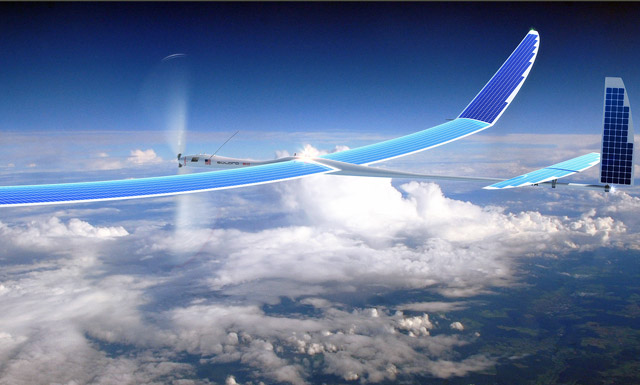Titan Aerospace has unveiled the Solara 50 and Solara 60, two high-altitude solar-powered UAVs the company is calling "atmospheric satellites". The aircraft are designed to fly up to 65,000ft (19,800m) altitude and remain there for up to weeks at a time, sustained by a 50m wingspan and a single large battery-powered propeller, itself powered by thousands of high-efficiency solar cells placed on virtually every possible surface. It is not the first multi-week "atmospheric satellite" aircraft. The Defense Advanced Research Projects Agency (DARPA) initiated a programme to develop just such a concept, resulting in AeroVironment's Global Observer, which was unfortunately destroyed in a crash, and QinetiQ's Zephyr, a demonstrator design for Boeing's Vulture concept. Though the Solara programme is unrelated, the programmes all share similar characteristics - multi-year endurance and a 65,000ft operating altitude. Between 60,000-70,000ft sits a "sweet spot", says Titan, where the average winds are less than 5kts.
 |
|---|
Titan Aerospace The Solara 50 (above) and Solara 60 high-altitude solar-powered UAVs are designed to fly up to 65,000ft altitude and remain there for up to weeks at a time |
The Solara will be launched with a catapult and cruise at 65,000ft at a maximum speed of around 60mph (97kmh), carrying a 70lb payload for up to five years before landing gently on its Kevlar-coated belly. The payload capacity varies greatly depending on the amount of available sunlight - operations during the longest days of the year could allow for up to an additional 100lb payload, supplied with 100 watts of electricity overnight and ranging into kilowatts during the day."We've been developing this for a number of years," says Max Yaney, who oversees technology aspects of the programme. "Obviously there are some very exciting programmes that have been attempted over the years. This is the holy grail of edge-of-space access.... We've taken the lessons learned from all of those programmes"."We make heavy use of the latest and greatest composite materials and advanced composite techniques developed over recent years," Yaney continues. "There are actually fantastic advances in composites that allow us to meet the strength and weight requirements. We employ the entire spectrum."A customer has reserved two Solara 50 aircraft to carry communications relay packages, but Titan declined to identify the customer. The first aircraft is under construction, expected to roll out in 2014.
Source: Flight Daily News



















